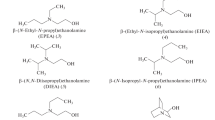Summary
From the point of view of an examination of neutral materials (carbohydrates, glycerine and 2,3-butanediol) in beverages a reliable procedure for categorising and quantitative gas chromatographic analysis of these compounds has been developed. Hexoses, sugar alcohols, glycerine and 2,3-butanediol are directly converted to trimethylsilyl derivatives, with the solvents-silylation reagent combination pyridine: hexamethyldisilazane (HMDS): trimethylchlorosilane = 7∶2∶1 and quantitatively determined by gas liquid chromatography on the stationary phases OV 17 and SE 52. Directly silylated pentoses and desoxyhexoses are not separated satisfactorily and are therefore reduced with sodiumborohydride in water to the corresponding alcohols and dtermined positively on Dexsil 300 as stationary phase after formation of the trimethylsilyl derivatives with 0.6 cm3 HMDS +0.4 cm3 TMCS in 1 cm3 dimethylsulfoxide +2 cm3 pyridine. In the quantitative evaluation it has to be taken into account that the height of the peak not only depends on the concentration of the trimethylsilyl derivative in the sample, but also that the volume of the injected sample influences the detector signal.
Zusammenfassung
Unter dem Aspekt der Untersuchung von Neutralstoffen (Kohlenhydraten, Glycerin und 2,3-Butandiol) in Naturstoffgemischen wurde ein reproduzierbares Verfahren zur Bestandsaufnahme und quantitativen gas-chromatographischen Analyse ausgearbeitet. Hexosen, Zuckeralkohle, Glycerin und 2,3-Butandiol werden mit der Lösungsmittel-Silylierungsreagens-Kombination Pyridin: Hexamethyldisilazan (HMDS): Trimethylchlorsilan (TMCS) = 7∶2∶1 derivatisiert und auf den stationären Phasen OV 17 und SE 52 gas-chromatographiert und quantitativ bestimmt. Pentosen und Desoxyhexosen, deren Trennung bei direkter Silylierung unbefriedigend verläuft, lassen sich nach Reduktion mit Natriumborhydrid im wäßrigen Milieu zu Pentiten und Desoxyhexiten und Umsetzung mit 0,6 cm3 HMDS +0,4 cm3 TMCS in 1 cm3 Dimethylsulfoxid +2 cm3 Pyridin auf Dexsil 300 eindeutig bestimmen. Bei quantitativen Auswertungen muß beachtet werden, daß die Größe der Peaks nicht nur von der Konzentration des Trimethylsilylderivates in der Probe abhängt, sondern auch das injizierte Volumen der Probe das Detektorsignal beeinflußt.
Similar content being viewed by others
Literatur
F. Drawert, V. Lessing u.G. Leupold, Chromatographia9, 373 (1976).
F. Drawert u.G. Leupold, Chromatographia9, 397 (1976).
F. Drawert, G. Leupold u.V. Lessing, Brauwiss., in Vorbereitung.
A. G. McInes, D. H. Ball u.C. T. Bishop, J. Chromatogr.1, 556 (1958).
C. T. Bishop, “Methods of Biochemical Analysis”, Vol. 10, New York (1962).
C. T. Bishop u.F. P. Cooper, Can. J. Chem.38, 793 (1960).
S. W. Günner, J. K. N. Jones u.M. B. Perry, Can. J. Chem.39, 1892 (1961).
H. W. Kirchner, Analytic. Chem.32, 1103 (1960).
H. G. Jones, J. K. N. Jones u.M. B. Perry, Can. J. Chem.40, 1559 (1962).
M. Vilkas, H. Jan, G. Boussac u.M. C. Bonnard, Tetrahedron Letters, 1441 (1966).
J. H. Sloneker “Biochemical Applications of Gas Chromatography”, Plenum Press, New York (1964).
C. C. Sweeley, R. Bentley, M. Makita u.W. W. Wells, J. Am. Chem. Soc.85, 2497 (1963).
G. G. S. Dutton, “Advances in Carbohydrate chemistry and biochemistry, Vol. 28, 9–160”, Academic Press, New York u. London (1973).
R. Varma, R. S. Varma u.A. H. Wardi, J. Chromatogr.77, 222 (1973).
K. Zürcher, H. Hadorn u.Chr. Strack, Mitt. Gebiete Lebensm. Hyg.66, 92 (1975).
B. S. Mason, u.H. T. Slover, J. Agr. Food Chem.19, 551 (1971).
G. Petersson, Carbohydrate Res.33, 47 (1974).
R. Laine u.Ch. Sweeley, Anal. Biochem.43, 533 (1971).
K. M. Brobst u.C. E. Lott, Am. Soc. Brew. Chem. Proc. 71 (1966).
R. Bentley u.N. Botlock, Anal. Biochem.20, 312 (1967).
T. E. Acree, R. S. Shallenberger u.L. R. Mattick, Carbohydrate Res.6, 498 (1968).
R. S. Shallenberger u.T. E. Acree, Carbohydrate Res.1, 495 (1966).
L. R. Whistler u.J. N. Bemillan, “Methods in Carbohydrate Chemistry, Vol. 1, 130”, Academic Press, New York u. London (1962).
A. E. Pierce, “Silylation of Organic Compounds”, Pierce Chemical Company, Rockford, Illinois (USA) (1968).
Th. Gheorghiu u.K. Oette, J. Chromatogr.48, 430 (1970).
E. W. Underhill u.D. F. Kirkland, J. Chromatogr.57, 47 (1971).
W. C. Ellis, J. Chromatogr.41, 325 (1969).
D. A. Kline, E. Fernandez-Flores u.A. R. Johnson, J. Assoc. Offic. Chem.53, 1198 (1970).
H. G. J. DeWilt, J. Chromatogr.63, 379 (1971).
J. Haverkamp, J. P. Kamerling u.J. F. G. Vliegenthart, J. Chromatogr.59, 281 (1971).
K. Lampiaho, T. Nikkari, J. Pikkarainen, J. Kärkäinen u.E. Kulonen, J. Chromatogr.64, 211 (1972).
K. Tesařik, J. Chromatogr.65, 295 (1972).
A. H. Weiss u.H. Tambawala, J. Chromatogr. Sci.10, 120 (1972).
G. Rumpf, J. Chromatogr.43, 247 (1969).
J. P. Kamerling, J. F. G. Vliegenthart, J. Vink u.J. J. De Ridder, Tetrahedron Letters27, 4275 (1971).
M. John u.H. Dellweg, Monatsschr. f. Brauerei26 (8), 145 (1973).
K. Zürcher u.H. Hadorn, DLR70(12), 425 (1974).
Th. Cayle, F. Viebrock u.J. Schiaffino, Wallerstein Lab. Commun.45, 154 (1968).
L. P. Zill, J. X. Khym u.G. M. Cheniae, J. Am. Chem. Soc.75, 1339 (1953).
R. D. Partridge u.A. H. Weiss, J. Chromatogr. Sci.8, 553 (1970).
W. Averill, Perkin Elmer Instrument News18(2), 10 (1967).
F. Drawert, G. Leupold u.V. Lessing, in Vorbereitung.
Author information
Authors and Affiliations
Additional information
Auszug aus der Dissertation von G. Leupold, TU München 1974
Rights and permissions
About this article
Cite this article
Drawert, F., Leupold, G. Quantitative gas-chromatographische Bestimmung von Neutralstoffen (Kohlenhydraten). Chromatographia 9, 447–453 (1976). https://doi.org/10.1007/BF02270734
Received:
Accepted:
Issue Date:
DOI: https://doi.org/10.1007/BF02270734



